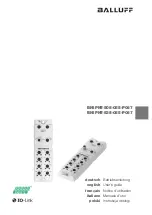
Adjustable-length control sticks
The control stick length is adjustable to make the transmitter more comfortable to
hold and operate. To adjust the length, hold the
locking piece (B)
and turn the
stick tip (A)
counterclockwise. Turn the locking piece B up or down to lengthen or
shorten the stick. When the length is suitable, lock the stick in position by turning
locking piece B counterclockwise.
Changing the 6EXA stick mode
The transmitter may be operated in four different stick
“
modes
”
(1, 2, 3 & 4). The modes
determine the functions that will be operated by control sticks. Currently, the transmitter is in
“
mode 2
”
and should be left in mode 2 unless you are an experienced flyer and have learned to
fly in a different mode. In mode 2, the right control stick operates the aileron and elevator and
the left stick operates the rudder and throttle. This is how 99% of Americans fly their models.
To change the mode, simultaneously depress the MODE and SELECT keys, then turn on the power. The current mode will
appear on the LCD screen. Push the DATA INPUT lever up or down to change the mode. If a mode is selected that moves the
throttle control to the right stick, the throttle detent mechanism will have to be moved as well. This can be done by the Futaba
Service Center. (See page 2)
FLYING SAFETY GUIDELINES
Find a suitable flying site
If you are a beginning modeler and not yet a member of an R/C club, joining a club and flying at a site specifically intended
for R/C model aircraft is
highly recommended
. In addition to joining a club, we strongly recommend joining the AMA
(Academy of Model Aeronautics). AMA membership is required to fly at AMA clubs. There are over 2,500 AMA-chartered clubs
across the country. Among other benefits, the AMA provides insurance to its members who fly at sanctioned sites and events.
Additionally, training programs and instructors are available at AMA club sites to help you get started the right way. Contact
the AMA at the address or toll-free phone number below:
Academy of Model Aeronautics
5151 East Memorial Drive
Muncie, IN 47302-9252
Tele. (800) 435-9262
Fax (765) 741-0057
Or via the Internet at: http://www.modelaircraft.org
IMPORTANT:
If you do insist on flying on your own, you
must
be aware of your proximity to R/C club sites. If there is an R/C
site within six miles of where you are flying, and if you are operating your model on the same frequency as somebody else,
there is a
strong
possibility that one or both models will crash due to radio interference. There is
great
potential for an out-
of-control model to cause property damage and/or severe personal injury. We
strongly
urge you to fly at an R/C club site
where frequency control is in effect so you can be confident you will be the only one flying on your channel.
Charge the batteries
Second to the pilot
’
s flight skills, one of the most important factors that can determine a model
’
s longevity is the state-of-
charge of the batteries
—
especially the on-board receiver pack. Inadequate charging and failing to monitor a battery
’
s voltage
may lead to low battery power, causing loss of control and a crash. To avoid this, always charge the batteries the night before
you go flying. If ever uncertain how much
“
charge
”
is left in a battery, it is wiser to err on the side of caution, rather than
trying to get in one last flight! Due to the number of factors that determine receiver battery power consumption (such as the
number and type of servos in your model, the type of flying you do, how much resistance is built into the controls, the size
of the model, etc.), it is not possible to recommend how many flights one can get on a charge. The best way to monitor battery
power and calculate how much flight time you have left is to use a volt meter to check the batteries after each flight. This
can be done through the battery charging plug coming from the switch. There are many small, hand-held volt meters available
specially intended for R/C use. The Hobbico
®
Digital Voltmeter MKIII
™
(HCAP0356) is one such unit. An on-board volt meter
mounted directly on the model (HCAP0330) can also be used.
18



































